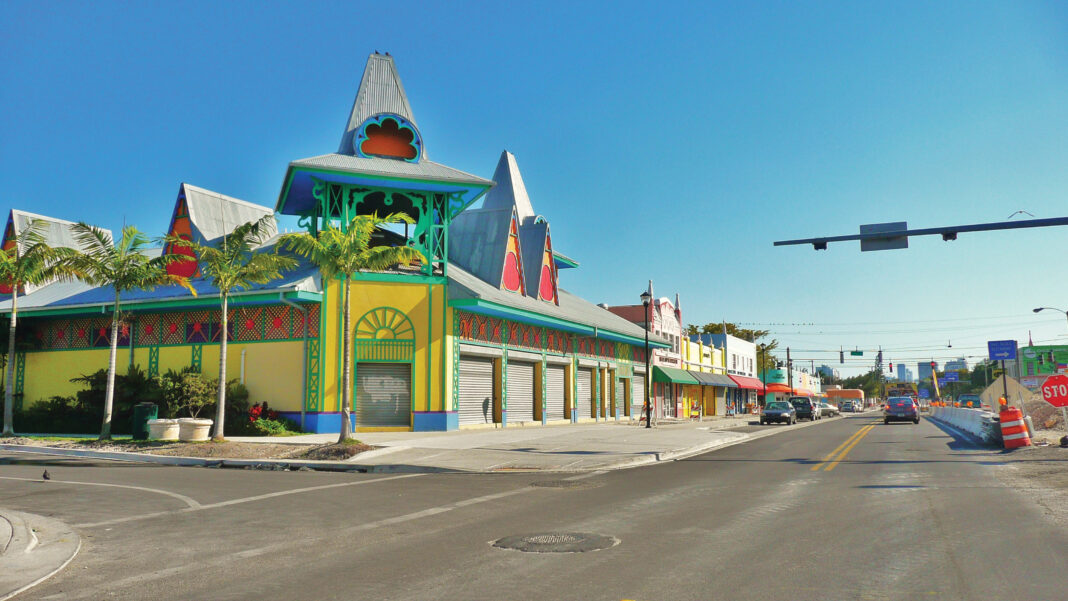
Amongst the sea of diverse communities that define South Florida, Little Haiti is one that has had a historic prevalence in the nation’s history, housing the largest population of Haitian Americans in the United States.
The neighborhood is a cultural and artistic mecca for the Haitian community in Florida, yet has recently been the target of climate gentrification, the process of people moving to areas less exposed to the effects of climate change, as defined by the Environmental Law Institute.
These populations are often wealthier and move into areas predominantly occupied by lower-income residents. Because of institutionalized practices like red-lining, these lower-income communities are often communities of color subject to less funding and resource allocation from the government.
With rising sea levels and heightened weather events due to climate change, Little Haiti is the premier in-land target for developers.
Housing affordability has been a significant struggle for the residents in Little Haiti, and according to a Florida International University housing market analysis in 2015, the majority of these residents rent their homes.
To support the financing of new housing and properties of incoming Floridians from the coast, rent is continuously being raised, causing the displacement of generations of Haitians in the area.
“One of the bigger issues – it’s like this in most cities but the City of Miami especially – is there’s no income tax,” Theresa Pinto, UM professor of ecosystem science and policy, said. “There’s no other forms of revenue except property taxes, so they’re reliant on that money. There’s no incentive either to try and stop this kind of process from going on.”
Approval of housing projects and revenue from higher-priced properties are not reinvested into the community, thus exacerbating the displacement of individuals, especially in an area like Little Haiti where over 40% of individuals are reported living below the federal poverty line.
Low investment into resources and community programs harms the necessary culture and history that flourishes there.
“I believe that we are often overlooked by the City of Miami,” senior nursing major and North Miami local Kimberly Dacius said. “I feel as though the City of Miami doesn’t value the culture and just views the community as a property enterprise.”
Gentrification in Little Haiti is nothing new. Since the 1980’s, there have been turnovers in investors who purchase property in the area in an attempt to sell to developers once the value has gone up.
“The City of Miami itself, where Little Haiti is located, is very resistant to considering the community voices.” Pinto said. “I’ve been to public hearing meetings where commissioners are yelling at community members and quieting them because they don’t want to yet deal with the issue.”
Climate gentrification falls into the hands of local governments, yet local leaders have demonstrated a lack of prioritization of people and the health of the planet, over profit.
In 2022, Miami commissioners passed a substantial and controversial zoning project, promising $1 billion toward building an 18-acre project coined the Magic City Innovation District.
The plan would enable developers to construct high-rise buildings to surround the neighborhood’s primarily single-story homes. The project seeks to revitalize the community, yet has been met with both endorsement and resistance from residents and neighborhood leaders.
Residents that endorse the plan do so under the premise of new job opportunities, and during a hearing for the Magic City project, commissioners agreed to promise a $250,000 scholarship fund for students seeking higher education in the area.
The resistance from community voices targeted the fact that funding for the new development bypassed much-needed investment into existing infrastructure and historic buildings. The project also included approval for the construction of a Cirque du Soleil pop-up theme park in the area, dismaying residents.
“A lot of times what happens is the structures aren’t really suitable for the wealthier populations. They’ll apply for an upzoning, so they’ll go to the local government, the local permitting office, and ask if they can build something bigger, something more expensive, and it’s often granted.” Pinto said. “Meanwhile, people in the community are trying to do additions also, and they don’t get the same consideration.”
The displacement of the Haitian community from their historic homes not only impacts the older, settled residents but also the youth in the neighborhood.
Frantzline Gaudard, a senior studying nursing and treasurer for Planet Kreyol, UM’s Haitian Student Organization, emphasizes the need for a neighborhood that brings Haitians together.
“It’s very important for the Haitian community to have its own neighborhood because it helps retain Haitian culture in the area, which helps others explore our culture but also for the youth to know what it means to be Haitian,” said Gaudard. “It gives the Haitians that live there a home away from home.”
Climate gentrification has long-standing implications for the communities that it impacts.
“It’s a huge problem that doesn’t really have an easy solution, and may never really have a final outcome.” Pinto said. “It’s a process regardless of whether it’s racially based or just income based– it will always have a role in our system.”





